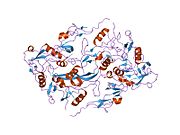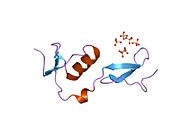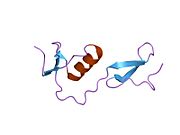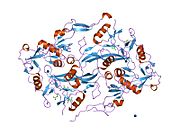Follistatin
| FST | |||
|---|---|---|---|
Gene ontology | |||
| Molecular function | |||
| Cellular component | |||
| Biological process | |||
| Sources:Amigo / QuickGO | |||
Ensembl | |||||||||
|---|---|---|---|---|---|---|---|---|---|
| UniProt | |||||||||
| RefSeq (mRNA) | |||||||||
| RefSeq (protein) | |||||||||
| Location (UCSC) | Chr 5: 53.48 – 53.49 Mb | Chr 13: 114.59 – 114.6 Mb | |||||||
| PubMed search | [3] | [4] | |||||||
| View/Edit Human | View/Edit Mouse |
Follistatin, also known as activin-bindings protein, is a
Its primary function is the binding and bioneutralization of members of the
An earlier name for the same protein was FSH-suppressing protein (FSP). At the time of its initial isolation from follicular fluid, it was found to inhibit the anterior pituitary's secretion of follicle-stimulating hormone (FSH).
Biochemistry
Follistatin is part of the inhibin-activin-follistatin axis.
Three isoforms, FS-288, FS-300, and FS-315 have been reported. Two, FS-288 and FS-315, are created by
Although FS is ubiquitous, its highest concentration is in the female ovary, followed by the skin.
Follistatin is produced by folliculostellate (FS) cells of the anterior pituitary. FS cells make numerous contacts with the classical endocrine cells of the anterior pituitary including gonadotrophs.
Function
In the tissues activin has a strong role in cellular proliferation, thereby making follistatin the safeguard against uncontrolled cellular proliferation and also allowing it to function as an instrument of cellular differentiation. These roles are vital in tissue rebuilding and repair, and may account for follistatin's high presence in the skin.
In the blood, activin and follistatin are involved in the
Follistatin is involved in embryo development. It has inhibitory action on bone morphogenic proteins (BMPs); BMPs induce the ectoderm to become epidermal ectoderm. Inhibition of BMPs allows neuroectoderm to arise from ectoderm, a process which eventually forms the neural plate. Other inhibitors involved in this process are noggin and chordin.
Follistatin and BMPs are play a role in
Clinical significance
This section needs to be updated. (November 2019) |
Follistatin is studied for its role in regulation of muscle growth in mice, as an antagonist to
Increased levels of follistatin, by leading to increased muscle mass of certain core muscular groups, can increase life expectancy in cases of spinal muscular atrophy (SMA) in animal models.[10]
Elevated circulating follistatin levels are also associated with increased risk of type 2 diabetes , early death, heart failure, stroke and chronic kidney disease. It has been demonstrated that follistatin contributes to insulin resistance in type 2 diabetes development and nonalcoholic fatty liver disease (NAFLD). The genetic regulation of follistatin secretion from the liver is via Glucokinase regulatory protein (GCKR) identified by large GWAS studies. [11] [12]
It is also investigated for its involvement in polycystic ovary syndrome (PCOS), in part to resolve debate as to its direct role in this disease.[13]
Sporadic inclusion body myositis, a variant of inflammatory myopathy, involves muscle weakness. In one clinical trial, rAAV1.CMV.huFS344, 6 × 1011 vg/kg, walk test results significantly improved versus untreated controls, along with decreased fibrosis and improved regeneration.
ACE-083, a follistatin-based fusion protein, was investigated for treatment focal or asymmetric myopathies. Intramuscular ACE-083 increased growth and force production in injected muscle in wild-type mice and mouse models of Charcot-Marie-Tooth disease (CMT) and Duchenne muscular dystrophy, without systemic effects or endocrine disruption.[14]
AAV-mediated FST reduced obesity-induced inflammatory
In another mouse study, high dose animals showed significant quadricep growth.
References
- ^ a b c GRCh38: Ensembl release 89: ENSG00000134363 – Ensembl, May 2017
- ^ a b c GRCm38: Ensembl release 89: ENSMUSG00000021765 – Ensembl, May 2017
- ^ "Human PubMed Reference:". National Center for Biotechnology Information, U.S. National Library of Medicine.
- ^ "Mouse PubMed Reference:". National Center for Biotechnology Information, U.S. National Library of Medicine.
- PMID 3120188.
- ^ PMID 11459787.
- PMID 11459935.
- ^ "'Mighty mice' made mightier". Retrieved 2008-02-26.
- ^ "Success Boosting Monkey Muscle Could Help Humans". NPR. 11 Nov 2009. Retrieved 2009-11-12.
- PMID 19074460.
- PMID 34759311.
- PMID 38000997.
- PMID 11022191.
- PMID 31388039.
- PMID 32426485.
Further reading
- Thompson TB, Lerch TF, Cook RW, Woodruff TK, Jardetzky TS (October 2005). "The structure of the follistatin:activin complex reveals antagonism of both type I and type II receptor binding". Developmental Cell. 9 (4): 535–543. PMID 16198295.
- Nakatani M, Takehara Y, Sugino H, Matsumoto M, Hashimoto O, Hasegawa Y, et al. (February 2008). "Transgenic expression of a myostatin inhibitor derived from follistatin increases skeletal muscle mass and ameliorates dystrophic pathology in mdx mice". FASEB Journal. 22 (2): 477–487. S2CID 10405000.
- Lambert-Messerlian G, Eklund E, Pinar H, Tantravahi U, Schneyer AL (2007). "Activin subunit and receptor expression in normal and cleft human fetal palate tissues". Pediatric and Developmental Pathology. 10 (6): 436–445. S2CID 13268973.
- Walsh S, Metter EJ, Ferrucci L, Roth SM (June 2007). "Activin-type II receptor B (ACVR2B) and follistatin haplotype associations with muscle mass and strength in humans". Journal of Applied Physiology. 102 (6): 2142–2148. PMID 17347381.
- Ogino H, Yano S, Kakiuchi S, Muguruma H, Ikuta K, Hanibuchi M, et al. (February 2008). "Follistatin suppresses the production of experimental multiple-organ metastasis by small cell lung cancer cells in natural killer cell-depleted SCID mice". Clinical Cancer Research. 14 (3): 660–667. PMID 18245525.
- Reis FM, Nascimento LL, Tsigkou A, Ferreira MC, Luisi S, Petraglia F (May 2007). "Activin A and follistatin in menstrual blood: low concentrations in women with dysfunctional uterine bleeding". Reproductive Sciences. 14 (4): 383–389. S2CID 28945135.
- Yerges LM, Klei L, Cauley JA, Roeder K, Kammerer CM, Moffett SP, et al. (December 2009). "High-density association study of 383 candidate genes for volumetric BMD at the femoral neck and lumbar spine among older men". Journal of Bone and Mineral Research. 24 (12): 2039–2049. PMID 19453261.
- Blount AL, Vaughan JM, Vale WW, Bilezikjian LM (March 2008). "A Smad-binding element in intron 1 participates in activin-dependent regulation of the follistatin gene". The Journal of Biological Chemistry. 283 (11): 7016–7026. PMID 18184649.
- Eichberger T, Kaser A, Pixner C, Schmid C, Klingler S, Winklmayr M, et al. (May 2008). "GLI2-specific transcriptional activation of the bone morphogenetic protein/activin antagonist follistatin in human epidermal cells". The Journal of Biological Chemistry. 283 (18): 12426–12437. PMID 18319260.
- Jones MR, Wilson SG, Mullin BH, Mead R, Watts GF, Stuckey BG (April 2007). "Polymorphism of the follistatin gene in polycystic ovary syndrome". Molecular Human Reproduction. 13 (4): 237–241. PMID 17284512.
- Torres PB, Florio P, Ferreira MC, Torricelli M, Reis FM, Petraglia F (July 2007). "Deranged expression of follistatin and follistatin-like protein in women with ovarian endometriosis". Fertility and Sterility. 88 (1): 200–205. PMID 17296189.
- Sidis Y, Mukherjee A, Keutmann H, Delbaere A, Sadatsuki M, Schneyer A (July 2006). "Biological activity of follistatin isoforms and follistatin-like-3 is dependent on differential cell surface binding and specificity for activin, myostatin, and bone morphogenetic proteins". Endocrinology. 147 (7): 3586–3597. PMID 16627583.
- Grusch M, Drucker C, Peter-Vörösmarty B, Erlach N, Lackner A, Losert A, et al. (November 2006). "Deregulation of the activin/follistatin system in hepatocarcinogenesis". Journal of Hepatology. 45 (5): 673–680. PMID 16935389.
- Chen M, Sinha M, Luxon BA, Bresnick AR, O'Connor KL (January 2009). "Integrin alpha6beta4 controls the expression of genes associated with cell motility, invasion, and metastasis, including S100A4/metastasin". The Journal of Biological Chemistry. 284 (3): 1484–1494. PMID 19011242.
- Blount AL, Schmidt K, Justice NJ, Vale WW, Fischer WH, Bilezikjian LM (March 2009). "FoxL2 and Smad3 coordinately regulate follistatin gene transcription". The Journal of Biological Chemistry. 284 (12): 7631–7645. PMID 19106105.
- Phillips DJ, de Kretser DM (October 1998). "Follistatin: a multifunctional regulatory protein". Frontiers in Neuroendocrinology. 19 (4): 287–322. S2CID 3023421.
- Chang SY, Kang HY, Lan KC, Hseh CY, Huang FJ, Huang KE (2006). "Expression of inhibin-activin subunits, follistatin and smads in granulosa-luteal cells collected at oocyte retrieval". Journal of Assisted Reproduction and Genetics. 23 (9–10): 385–392. PMID 17053951.
- Kostek MA, Angelopoulos TJ, Clarkson PM, Gordon PM, Moyna NM, Visich PS, et al. (May 2009). "Myostatin and follistatin polymorphisms interact with muscle phenotypes and ethnicity". Medicine and Science in Sports and Exercise. 41 (5): 1063–1071. PMID 19346981.
- Flanagan JN, Linder K, Mejhert N, Dungner E, Wahlen K, Decaunes P, et al. (August 2009). "Role of follistatin in promoting adipogenesis in women". The Journal of Clinical Endocrinology and Metabolism. 94 (8): 3003–3009. PMID 19470636.
- Peng C, Ohno T, Khorasheh S, Leung PC (1996). "Activin and follistatin as local regulators in the human ovary". Biological Signals. 5 (2): 81–89. PMID 8836491.
External links
- Follistatin at the U.S. National Library of Medicine Medical Subject Headings (MeSH)
- Overview of all the structural information available in the PDB for UniProt: P19883 (Follistatin) at the PDBe-KB.






